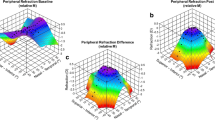Abstract
The goal of this study was to compare differences in the mean angle kappa and its intercepts before and after photorefractive keratectomy (PRK) for myopia. In a prospective controlled study, myopic patients were treated with aspheric wavefront-guided (personalized) PRK with a Bausch & Lomb Technolas 217z excimer laser. The manifest refraction, visual acuity, and angle kappa were evaluated preoperatively and at 1 and 6 months postoperatively. The same operator performed all angle kappa measurements using Orbscan IIz. A total of 48 cases (96 eyes, 68.75 % female) with a mean age of 26.70 ± 4.89 years (18–34 years) were treated. The preoperative and postoperative mean angle kappa values were not significantly different (4.97 ± 1.24 vs 4.99 ± 1.10 at 6 months). The average horizontal distance (x-intercept) between the visual axis and pupillary axis intersection on the corneal surface measured before surgery (−0.562 ± 0.074 mm) did not significantly differ from the values measured at 1 and 6 months after surgery (−0.559 ± 0.048 and −0.554 ± 0.055 mm, respectively). Similarly, the average vertical distance (y-intercept) values did not differ before and at 1 and 6 months after surgery (0.156 ± 0.225, 0.142 ± 0.040, and 0.149 ± 0.33 mm, respectively). No differences in the angle kappa or its corneal intercepts were observed between pre- and post-PRK. This finding implies that PRK does not change the corneal vertex locations.
Similar content being viewed by others
References
Scott WE, Mash AJ (1973) Kappa angle measures of strabismic and nonstrabismic individuals. Arch Ophthalmol 89:18–20
Basmak H, Sahin A, Yildirim N, Saricicek T, Yurdakul S (2007) The angle kappa in strabismic individuals. Strabismus 15:193–196
Qazi MA, Roberts CJ, Mahmoud AM, Pepose JS (2005) Topographic and biomechanical differences between hyperopic and myopic laser in situ keratomileusis. J Cataract Refract Surg 31:48–60
Chan CC, Boxer Wachler BS (2006) Centration analysis of ablation over the coaxial corneal light reflex for hyperopic LASIK. J Refract Surg 22:467–471
Pande M, Hillman JS (1993) Optical zone centration in keratorefractive surgery; entrance pupil center, visual axis, coaxially sighted corneal reflex, or geometric corneal center? Ophthalmology 100:1230–1237
Uozato H, Guyton DL (1987) Centering corneal surgical procedures. Am J Ophthalmol 103:264–275
Lafond G, Bonnet S, Solomon L (2004) Treatment of previous decentered excimer laser ablation with combined myopic and hyperopic ablations. J Refract Surg 20:139–148
Boxer Wachler BS, Korn TS, Chandra NS, Michel FK (2003) Decentration of the optical zone: centering on the pupil versus the coaxially sighted corneal light reflex in LASIK for hyperopia. J Refract Surg 19:464–465
Pamel G, Kanellopoulos AJ, Perry HD (2007) Comparison of topography-guided (TGL) to standard LASIK (SL) for hyperopia. How important is adjustment for angle kappa? AAO meeting 2007, poster 178
Kanellopoulos AJ (2005) Topography-guided custom re-treatments in 27 symptomatic eyes. J Refract Surg 21:S513–S518
Pallikaris IG, Siganos DS (1997) Laser in situ keratomileusis to treat myopia: early experience. J Cataract Refract Surg 23:39–49
Loper LR (1959) The relationship between angle lambda and the residual astigmatism of the eyes. Am J Optom 36:365–377
Basmak H, Sahin A, Yildirim N, Papakostas TD, Kanellopoulos AJ (2007) Measurement of angle kappa with synoptophore and Orbscan II in a normal population. J Refract Surg 23:456–460
Hashemi H, KhabazKhoob M, Yazdani K, Mehravaran Sh, Jafarzadehpur E et al (2010) Distribution of angle kappa measurements with Orbscan IIz in a population-based survey. J Refract Surg 26(12):966–971
Acknowledgments
The authors would like to thank Pardis Eghbali BSc for her help in Orbscans measurements, Maryam Kadkhoda BSc and Jalil Rahimi BS for their help in optometric tests, Parisa Eghbali MSc for her assistance in statistical analysis. This work was part of ophthalmology specialty thesis of Dr Mojtaba Abrishami and was supported by research Grant No. 88708 from office of Vice-Chancellor for Research Affairs of Mashhad University of Medical Sciences.
Conflict of interest
The authors declare that there is no conflict of interest.
Author information
Authors and Affiliations
Corresponding author
Rights and permissions
About this article
Cite this article
Zarei-Ghanavati, S., Gharaee, H., Eslampour, A. et al. Angle kappa changes after photorefractive keratectomy for myopia. Int Ophthalmol 34, 15–18 (2014). https://doi.org/10.1007/s10792-013-9775-x
Received:
Accepted:
Published:
Issue Date:
DOI: https://doi.org/10.1007/s10792-013-9775-x




